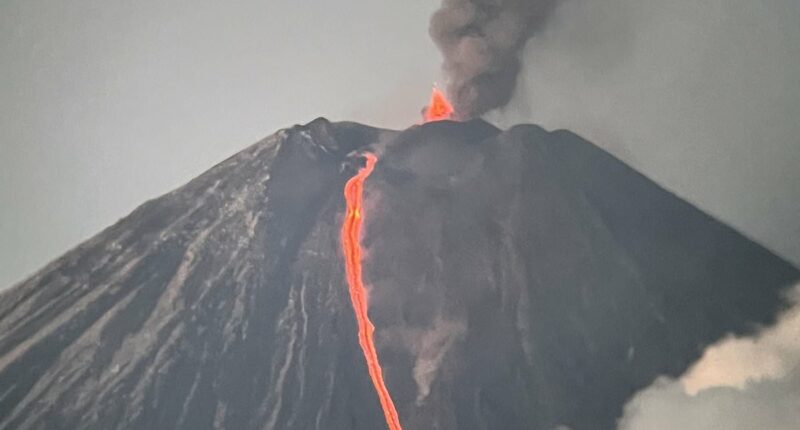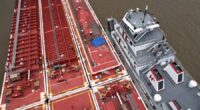Share this @internewscast.com
A strong earthquake near Russia’s Kamchatka Peninsula on July 29 triggered a series of volcanic eruptions along the Pacific Ring of Fire.
The 8.8 magnitude quake, followed by multiple aftershocks as strong as magnitude 6, appears to have reawakened long-dormant giants.
Klyuchevskaya Sopka erupted a day after the seismic event for the first time in 600 years.
Several other volcanoes, Shiveluch, Bezymianny, Karymsky and Avachinsky, have also roared back to life after roughly 300 years of dormancy.
Meanwhile, scientists have detected a thermal anomaly at Mutnovsky, indicating rising heat and suggesting an eruption may be imminent.
Ilias Papadopoulos, an engineering seismologist at the University of the West Indies, shared with the Daily Mail: ‘I’ve seen reports of [several volcanoes] erupting, which is a rare situation. Since the activity is ongoing, the counts may fluctuate over time.’
He also noted that the region between Russia and Alaska is one of Earth’s most seismically and volcanically active zones, yet the concurrent activity of numerous volcanoes is uncommon.
Papadopoulos mentioned that even if more eruptions occur in the Ring of Fire, the threat to human life should remain minimal, though he remarked: ‘It would certainly create an intriguing event.’

The Ring of Fire, a 25,000-mile arc encircling the Pacific Ocean, is home to 75 percent of the world’s active volcanoes and frequent earthquake

Klyuchevskaya Sopka erupted on for the first time in 600 years. It shot out a massive plume six miles above sea level
The Ring of Fire forms a 25,000-mile horseshoe-shaped belt of volcanoes and fault lines around the Pacific Ocean, containing about 75 percent of the world’s active volcanoes and experiencing frequent earthquakes.
Data from the US Geological Survey (USGS) indicated that the earthquake occurred approximately 84 miles east-southeast of Kamchatka at around 7:24pm ET, marking it as the sixth strongest ever recorded.
It was also believed to be the most powerful quake anywhere on Earth in 14 years, since the 9.1-magnitude megaquake that struck northeastern Japan in 2011, leaving 19,747 people dead or missing.
A Russian seismologist told local media there is a direct link between the powerful quake and the surge in volcanic activity across Kamchatka.
David Pyle, a professor of Earth Science at the University of Oxford, told the Daily Mail: ‘This pattern is quite typical of the aftermath of very large ‘subduction zone’ earthquakes, as seen for example in Chile after some very large earthquakes of the 19th and 20th centuries.’
Klyuchevskaya Sopka sent a towering ash plume six miles into the sky when it erupted on July 30.
Located around 280 miles north of the regional capital, Petropavlovsk-Kamchatsky, it is one of the tallest volcanoes in the world, rising 15,584 feet above sea level.
‘Klyuchevskaya was already at an elevated state and was expected to erupt; the earthquake just gave it the extra energy to do it after the event,’ Papadopoulos explained.

Data from the US Geological Survey (USGS) showed the earthquake struck about 84 miles east-southeast of Kamchatska at around 7:24pm ET, marking the sixth strongest earthquake ever

Klyuchevskaya Sopka erupted on July 30, shooting an ash plume six miles high. About 280 miles north of Petropavlovsk-Kamchatsky, it stands 15,584 feet tall, making it one of the world’s tallest volcanoes
Pyle echoed that view, saying: ‘It is plausible that the volcano was a ”triggered” eruption in response to the earthquake.
‘With the other volcanoes that were already erupting, it may take some analysis to determine the extent to which the earthquake caused transient changes in activity.
Michael Manga, a geoscientist at the University of California, Berkeley, told the Daily Mail that while it’s unclear whether more volcanoes across the Ring of Fire will erupt, he is ‘curious to see what happens.’
Although the overall threat remains low, Manga noted the earthquake raised eruption chances by five to 12 percent.
That means a volcano with a typical one percent annual eruption risk could now face a 1.1 percent chance.

Scientists have detected a thermal anomaly at Mutnovsky, indicating rising heat and suggesting an eruption may be imminent.
The heightened threat may last from two months to two years, as the earthquake’s effects on underground pressure and magma systems can take time to unfold.
Large earthquakes like this one can influence volcanoes in several ways, even from afar.
When tectonic plates abruptly shift, they release tremendous energy in the form of seismic waves. These waves can increase stress within magma chambers or open new fractures in the crust, creating pathways for magma to rise.
Shaking can also disturb gas bubbles inside magma, making it more buoyant and unstable, conditions ripe for an eruption.
Volcanoes already active or ‘primed,’ with magma close to the surface, are the most vulnerable to this kind of seismic triggering.

















